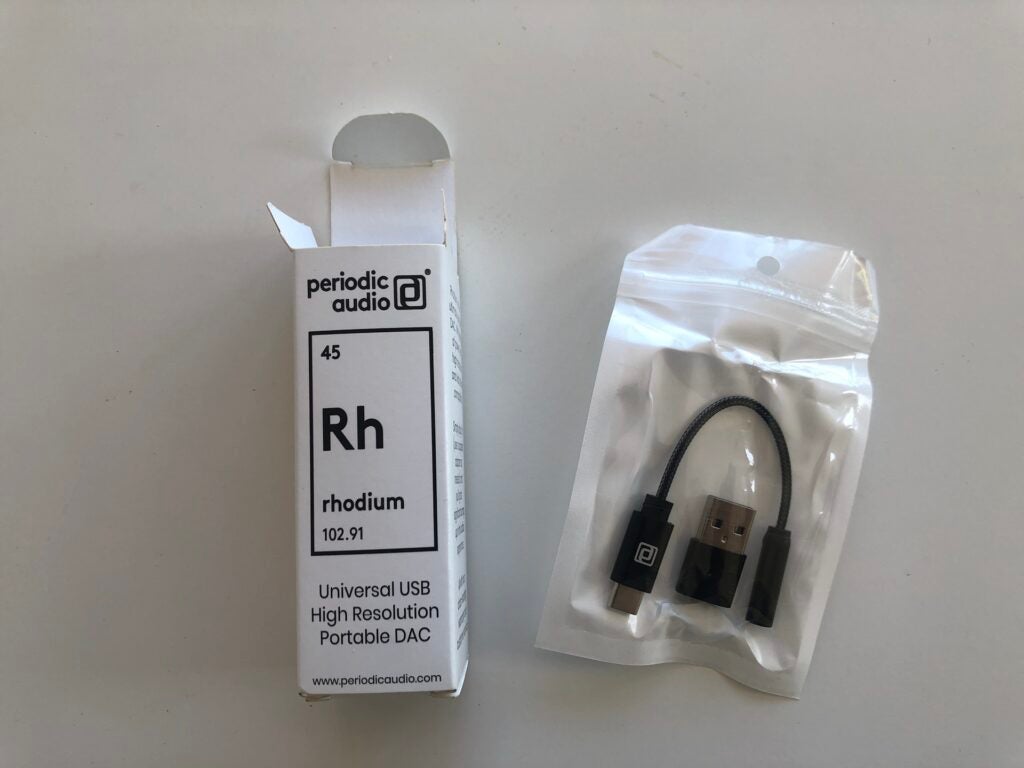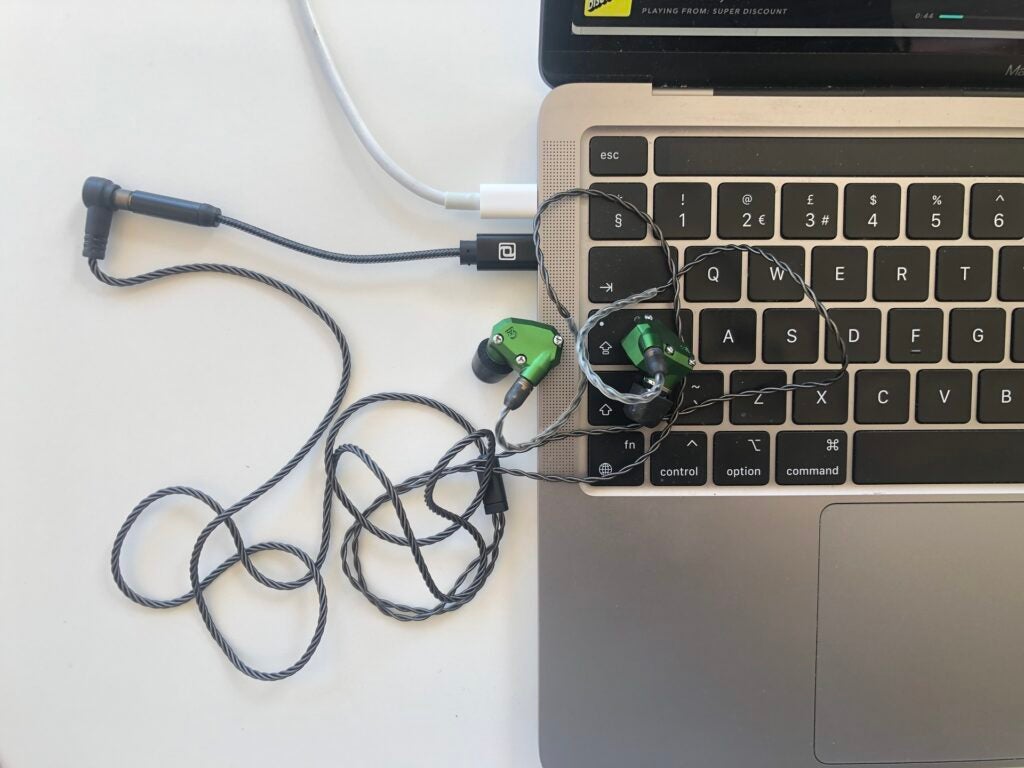The Rhodium DAC makes a big difference to music but it turns out to be not quite enough. Not everything it attempts to do is entirely positive, and consequently it’s not as easy to recommend even in light of its modest price.
Pros
- Brings wired connectivity to (most) smartphones
- Open, revealing sound
- Compact and well-made
Cons
- High-end reproduction is too assertive
-
ConnectivityUSB-C with USB-A adapter -
DACRealtek ALC5685 DAC
Introduction
‘Wireless’ may be the word, but not everyone is sold on the concept. Some people understand that the best pound-for-pound performance to be had from a pair of headphones, for example, is from a hard-wired pair.
But the sight of a headphone socket on a smartphone is becoming rare, and half-decent sound from the headphone socket on a laptop is rarer still. So what’s to be done if you’d like to hear what your wired headphones are capable of?
Periodic Audio of California wants to help. Its little Rhodium DAC/headphone amp is small and light, remarkably specified, and has a USB-C input at one end and a 3.5mm analogue socket at the other. So it can turn your smartphone into a source for wired headphones, and/or make a big improvement to the sound of your laptop, without costing a fortune.
That’s the theory, anyhow.
Availability
- UKRRP: £49
- USARRP: $49
- EuropeTBC
- CanadaTBC
- AustraliaTBC
The Periodic Audio Rhodium DAC/headphone amp is on sale now, and in the UK it’s priced at £49. In its native America the price is $49, while Australia customers should expect to part with AU$79 or thereabouts.
You hardly need me to point out this is not a lot of money. Admittedly the Rhodium is not a lot of thing, but if its effect on the sound of your headphones is half as pronounced as Periodic Audio claims, then it’s going to be one of the most cost-effective upgrades you’re ever likely to make.
It’s quite a big ‘if’, though, isn’t it?
Design
- Weighs just 6g
- 11 x 8 x 140mm
- …and that’s everything
As befits a product designed to sit between the USB-C output of your music storage device and the 3.5mm socket of your headphones, the Rhodium is small, light and functional.

At one end there’s an aluminium USB-C plug (there’s a small USB-C/USB-A adapter in the Rhodium’s somewhat medical-looking packaging), at the other there’s an aluminium 3.5mm analogue input. In between, there’s 63mm of braided cable.
In short, then, the Rhodium is a utilitarian design, which is precisely what a product like this should be.
Features
- 32bit.384kHz PCM compatibility
- Realtek ALC5685 DAC
- …and that’s everything
Almost all the Rhodium’s meaningful features are concealed inside the tiny aluminium shell that houses its USB-C socket. And by ‘features’, what I really mean is ‘feature’.
Here’s where the digital-to-analogue converter is kept. It’s a Realtek ALC5685 system-on-chip arrangement, just 6 x 6mm in size and capable of dealing with PCM digital audio files of up to 32bit/384kHz resolution.
Periodic Audio is making some bold claims for the Rhodium’s performance, including frequency response of a super-low 5Hz to a pointlessly high 160kHz, signal-to-noise ratio of 108dB and total harmonic distortion of a vanishingly low 0.007%, as well as very low power consumption.
It’s safe to say that if any of those figures are accurate, the Rhodium will perform beyond any realistic expectations you might have when the price and configuration of the product are taken into account.
Sound Quality
- Greater detail, improved dynamics
- Altogether more low-end punch and extension
- Relentless in its presentation
The Rhodium’s 3.5mm input is used to connect a pair of Campfire Audio Andromeda wired in-ear monitors at one end, and its USB-C socket attached to an Apple MacBook Pro (2020) at the other (because it’s handy to contrast the DAC’s performance to that of the laptop’s 3.5mm analogue socket). It’s also hooked to a Samsung Galaxy S21 smartphone from 2021 (which, of course, is socket only way to use wired headphones with this (and most other) smartphones).
From both sources, the Tidal app is used to deliver digital audio – Big Thief’s Shark Smile and Low Light by The Soundcarriers in particular. And no matter whether it’s the laptop or the smartphone I’m listening to, the Periodic Audio Rhodium proves a stable, consistent and remarkably upfront listen.
The laptop is the most helpful device here, of course, because it’s possible to listen to its internal DAC and headphone amplification directly against the Rhodium. And while every laptop owner understands its audio circuitry is generally little more than an afterthought, the difference the Rhodium makes is nevertheless quite startling.
Compared to the unassisted sound of the MacBook Pro, the Periodic Audio is an altogether more direct, more upfront and more assertive listen. It extracts and retains a lot more midrange information than the laptop, which means voices are considerably more informative, more characterful and more nuanced, which is basically a long-winded way of saying ‘more enjoyable’.

There’s greater punch and solidity to low-frequency sounds, and a bigger, better-defined soundstage on which all the action occurs. And dynamics (both the broad ‘quiet/LOUD’ stuff and the more subtle harmonic variations in each individual strum of a guitar) are improved – or, more accurately, more obvious in their effects.
Control, as it relates to the attack and decay of individual notes or hits, is much improved. Rhythmic expression is pretty decent, too, thanks to those punchy-yet-controlled lower frequencies. Tonality, especially from the bottom of the frequency to the point where ‘midrange’ becomes ‘high frequencies’, is wider-ranging in its variation, more assured in its musicality, and superior where both timbre and texture are concerned.
It’s at the top of the frequency range that the Rhodium overplays its hand somewhat. All of the improvements that are apparent elsewhere over the unassisted sound of the laptop – greater detail retention, better dynamic variation, more space and ‘airiness’ are apparent, but the unblinking way this DAC attacks treble sounds is quite wearing.
There’s a relentless quality to the way the Periodic Audio serves up the top end, a determination to sink its teeth in even if it’s not appropriate, and as a consequence the highest frequencies have a hardness and an edginess about them that’s tiring at moderate volumes and almost painful at bigger levels. ‘Lively’ is all well and good where sound is concerned, ‘intransigence’ not so much.
Latest deals
Should you buy it?
You want to give your smartphone a headphone socket. This is an affordable and effective way to open your source player up to wired headphones.
You don’t consider ‘lively’ a positive where sound is concerned. The Rhodium’s high-end reproduction will tire you out sooner rather than later.
Final Thoughts
Ultimately, being tiny and affordable yet making a big difference to audio performance turns out to be not quite enough. For £49 the Periodic Audio Rhodium can have a remarkable effect on the sound of your laptop’s headphone output – but it’s not entirely positive, and consequently it’s not especially easy to recommend the outlay (modest though it is).
How we test
We test every DAC we review thoroughly over an extended period of time. We use industry standard tests to compare features properly. We’ll always tell you what we find. We never, ever, accept money to review a product.
Find out more about how we test in our ethics policy.
Tested with real world use
FAQs
To make the Rhodium compatible with iOS devices you would need the Apple Camera adapter, but Periodic say that compatibility is not guaranteed with iOS products.
Sustainability
Trusted Reviews’ holds the fact that global warming is not a myth as a core value and will continuously endeavour to help protect our planet from harm in its business practices.
As part of this mission, whenever we review a product we send the company a series of questions to help us gauge and make transparent the impact the device has on the environment.
We currently haven’t received answers to the questions on this product, but will update this page the moment we do. You can see a detailed breakdown of the questions we ask and why in our sustainability info page.
Jargon buster
Midrange
Midrange refers to the part of the frequency range that sits between the bass and treble. The midrange is the area that handles vocals and most of the instruments heard in a track. It can also be in reference to midrange loudspeaker drivers that replicate this area of the frequency range.
Hi-Res Audio
Hi-Res audio is referred to as a standard as well as a marketing term that describes digital audio files of better-than-CD quality (16-bit/44.1kHz).
The Rhodium DAC makes a big difference to music but it turns out to be not quite enough. Not everything it attempts to do is entirely positive, and consequently it’s not as easy to recommend even in light of its modest price.
Pros
- Brings wired connectivity to (most) smartphones
- Open, revealing sound
- Compact and well-made
Cons
- High-end reproduction is too assertive
-
ConnectivityUSB-C with USB-A adapter -
DACRealtek ALC5685 DAC
Introduction
‘Wireless’ may be the word, but not everyone is sold on the concept. Some people understand that the best pound-for-pound performance to be had from a pair of headphones, for example, is from a hard-wired pair.
But the sight of a headphone socket on a smartphone is becoming rare, and half-decent sound from the headphone socket on a laptop is rarer still. So what’s to be done if you’d like to hear what your wired headphones are capable of?
Periodic Audio of California wants to help. Its little Rhodium DAC/headphone amp is small and light, remarkably specified, and has a USB-C input at one end and a 3.5mm analogue socket at the other. So it can turn your smartphone into a source for wired headphones, and/or make a big improvement to the sound of your laptop, without costing a fortune.
That’s the theory, anyhow.
Availability
- UKRRP: £49
- USARRP: $49
- EuropeTBC
- CanadaTBC
- AustraliaTBC
The Periodic Audio Rhodium DAC/headphone amp is on sale now, and in the UK it’s priced at £49. In its native America the price is $49, while Australia customers should expect to part with AU$79 or thereabouts.
You hardly need me to point out this is not a lot of money. Admittedly the Rhodium is not a lot of thing, but if its effect on the sound of your headphones is half as pronounced as Periodic Audio claims, then it’s going to be one of the most cost-effective upgrades you’re ever likely to make.
It’s quite a big ‘if’, though, isn’t it?
Design
- Weighs just 6g
- 11 x 8 x 140mm
- …and that’s everything
As befits a product designed to sit between the USB-C output of your music storage device and the 3.5mm socket of your headphones, the Rhodium is small, light and functional.

At one end there’s an aluminium USB-C plug (there’s a small USB-C/USB-A adapter in the Rhodium’s somewhat medical-looking packaging), at the other there’s an aluminium 3.5mm analogue input. In between, there’s 63mm of braided cable.
In short, then, the Rhodium is a utilitarian design, which is precisely what a product like this should be.
Features
- 32bit.384kHz PCM compatibility
- Realtek ALC5685 DAC
- …and that’s everything
Almost all the Rhodium’s meaningful features are concealed inside the tiny aluminium shell that houses its USB-C socket. And by ‘features’, what I really mean is ‘feature’.
Here’s where the digital-to-analogue converter is kept. It’s a Realtek ALC5685 system-on-chip arrangement, just 6 x 6mm in size and capable of dealing with PCM digital audio files of up to 32bit/384kHz resolution.
Periodic Audio is making some bold claims for the Rhodium’s performance, including frequency response of a super-low 5Hz to a pointlessly high 160kHz, signal-to-noise ratio of 108dB and total harmonic distortion of a vanishingly low 0.007%, as well as very low power consumption.
It’s safe to say that if any of those figures are accurate, the Rhodium will perform beyond any realistic expectations you might have when the price and configuration of the product are taken into account.
Sound Quality
- Greater detail, improved dynamics
- Altogether more low-end punch and extension
- Relentless in its presentation
The Rhodium’s 3.5mm input is used to connect a pair of Campfire Audio Andromeda wired in-ear monitors at one end, and its USB-C socket attached to an Apple MacBook Pro (2020) at the other (because it’s handy to contrast the DAC’s performance to that of the laptop’s 3.5mm analogue socket). It’s also hooked to a Samsung Galaxy S21 smartphone from 2021 (which, of course, is socket only way to use wired headphones with this (and most other) smartphones).
From both sources, the Tidal app is used to deliver digital audio – Big Thief’s Shark Smile and Low Light by The Soundcarriers in particular. And no matter whether it’s the laptop or the smartphone I’m listening to, the Periodic Audio Rhodium proves a stable, consistent and remarkably upfront listen.
The laptop is the most helpful device here, of course, because it’s possible to listen to its internal DAC and headphone amplification directly against the Rhodium. And while every laptop owner understands its audio circuitry is generally little more than an afterthought, the difference the Rhodium makes is nevertheless quite startling.
Compared to the unassisted sound of the MacBook Pro, the Periodic Audio is an altogether more direct, more upfront and more assertive listen. It extracts and retains a lot more midrange information than the laptop, which means voices are considerably more informative, more characterful and more nuanced, which is basically a long-winded way of saying ‘more enjoyable’.

There’s greater punch and solidity to low-frequency sounds, and a bigger, better-defined soundstage on which all the action occurs. And dynamics (both the broad ‘quiet/LOUD’ stuff and the more subtle harmonic variations in each individual strum of a guitar) are improved – or, more accurately, more obvious in their effects.
Control, as it relates to the attack and decay of individual notes or hits, is much improved. Rhythmic expression is pretty decent, too, thanks to those punchy-yet-controlled lower frequencies. Tonality, especially from the bottom of the frequency to the point where ‘midrange’ becomes ‘high frequencies’, is wider-ranging in its variation, more assured in its musicality, and superior where both timbre and texture are concerned.
It’s at the top of the frequency range that the Rhodium overplays its hand somewhat. All of the improvements that are apparent elsewhere over the unassisted sound of the laptop – greater detail retention, better dynamic variation, more space and ‘airiness’ are apparent, but the unblinking way this DAC attacks treble sounds is quite wearing.
There’s a relentless quality to the way the Periodic Audio serves up the top end, a determination to sink its teeth in even if it’s not appropriate, and as a consequence the highest frequencies have a hardness and an edginess about them that’s tiring at moderate volumes and almost painful at bigger levels. ‘Lively’ is all well and good where sound is concerned, ‘intransigence’ not so much.
Latest deals
Should you buy it?
You want to give your smartphone a headphone socket. This is an affordable and effective way to open your source player up to wired headphones.
You don’t consider ‘lively’ a positive where sound is concerned. The Rhodium’s high-end reproduction will tire you out sooner rather than later.
Final Thoughts
Ultimately, being tiny and affordable yet making a big difference to audio performance turns out to be not quite enough. For £49 the Periodic Audio Rhodium can have a remarkable effect on the sound of your laptop’s headphone output – but it’s not entirely positive, and consequently it’s not especially easy to recommend the outlay (modest though it is).
How we test
We test every DAC we review thoroughly over an extended period of time. We use industry standard tests to compare features properly. We’ll always tell you what we find. We never, ever, accept money to review a product.
Find out more about how we test in our ethics policy.
Tested with real world use
FAQs
To make the Rhodium compatible with iOS devices you would need the Apple Camera adapter, but Periodic say that compatibility is not guaranteed with iOS products.
Sustainability
Trusted Reviews’ holds the fact that global warming is not a myth as a core value and will continuously endeavour to help protect our planet from harm in its business practices.
As part of this mission, whenever we review a product we send the company a series of questions to help us gauge and make transparent the impact the device has on the environment.
We currently haven’t received answers to the questions on this product, but will update this page the moment we do. You can see a detailed breakdown of the questions we ask and why in our sustainability info page.
Jargon buster
Midrange
Midrange refers to the part of the frequency range that sits between the bass and treble. The midrange is the area that handles vocals and most of the instruments heard in a track. It can also be in reference to midrange loudspeaker drivers that replicate this area of the frequency range.
Hi-Res Audio
Hi-Res audio is referred to as a standard as well as a marketing term that describes digital audio files of better-than-CD quality (16-bit/44.1kHz).

























